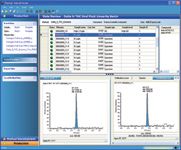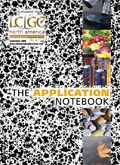Confirmation and Quantitation of THC in Oral Fluid Using an MRM Method on the TSQ Quantum GC
Analysis of oral fluids has become a popular biological fluid to analyze for drugs of abuse as an alternative to blood and urine.
Analysis of oral fluids has become a popular biological fluid to analyze for drugs of abuse as an alternative to blood and urine. Since Δ9-tetrahydrocannabinol (THC), the active ingredient found in marijuana, is one of the most common illegally used drugs, its analysis in oral fluid has become routine. This analysis can be extremely challenging due to the low concentrations of THC in oral fluid, the low volume of oral fluid typically available for analysis, and the chemical background from the oral fluid matrix. The work presented here demonstrates that the TSQ Quantum GC™ operated in multiple reaction monitoring (MRM) mode is both selective and sensitive enough to routinely measure THC in oral fluid at a 2 ng/mL cutoff.
Experimental Conditions
For this assay, THC-D3 was used as the deuterated internal standard. The 200 μL oral fluid samples were first extracted using solid phase extraction with Thermo Scientific HyperSep Verify AX columns. After extraction, the samples were derivatized with bis (trimethylsilyl) trifluoroacetamide (BSTFA). Known negative oral fluid calibration standard was spiked and extracted at 0.2, 2, and 20 ng/mL for use as calibrators. The silylated reaction products were analyzed using the TSQ Quantum GC triple stage quadrupole GC–MS-MS system operated in MRM mode. One quantitation transition and one confirming transition were monitored for both the analyte and internal standard.

Figure 1: Examples of THC quantitation and qualifi er ions monitored at 0.2 ng/mL.
Results
The analysis of THC in oral fluids using the TSQ Quantum GC system was validated for linear range, carryover, and precision. The linear range for the assay was demonstrated to be between 0.2 to 20 ng/mL, with each of four injections at 0.2 ng/mL quantitating at less than 5% deviation from the theoretical amount and at an average deviation of 2%. Across this range, all samples also gave ion ratios which were within 20% of the expected ion ratios defined by the calibrators. Intra- and inter-day precision studies demonstrated that the coefficients of variation for the assay at 0.8 and 2.5 ng/mL were between 3 and 6%.
Conclusion
The TSQ Quantum GC operated in multiple reaction monitoring mode proved to be both selective and sensitive enough to routinely measure THC in oral fluid at a 2 ng/mL cutoff level. This was exemplified during the linearity study, where all four injections at 0.2 ng/mL quantified within 5% of the actual amount.
Setup and daily use of this method was as easy as for a typical single quadrupole confirmation method, without requiring a complex multi-dimensional GC approach. Also, the ease of developing an MRM confirmation method on the TSQ Quantum GC allows the user more flexibility in expanding to other confirmation assays that prove difficult to analyze on a GC single quadrupole instrument.

Thermo Fisher Scientific, Inc.
355 River Oaks Parkway, San Jose, CA 95134
tel. (800)532-4752; fax (561)688-8731
Website: www.thermo.com

SEC-MALS of Antibody Therapeutics—A Robust Method for In-Depth Sample Characterization
June 1st 2022Monoclonal antibodies (mAbs) are effective therapeutics for cancers, auto-immune diseases, viral infections, and other diseases. Recent developments in antibody therapeutics aim to add more specific binding regions (bi- and multi-specificity) to increase their effectiveness and/or to downsize the molecule to the specific binding regions (for example, scFv or Fab fragment) to achieve better penetration of the tissue. As the molecule gets more complex, the possible high and low molecular weight (H/LMW) impurities become more complex, too. In order to accurately analyze the various species, more advanced detection than ultraviolet (UV) is required to characterize a mAb sample.

.png&w=3840&q=75)

.png&w=3840&q=75)



.png&w=3840&q=75)



.png&w=3840&q=75)














